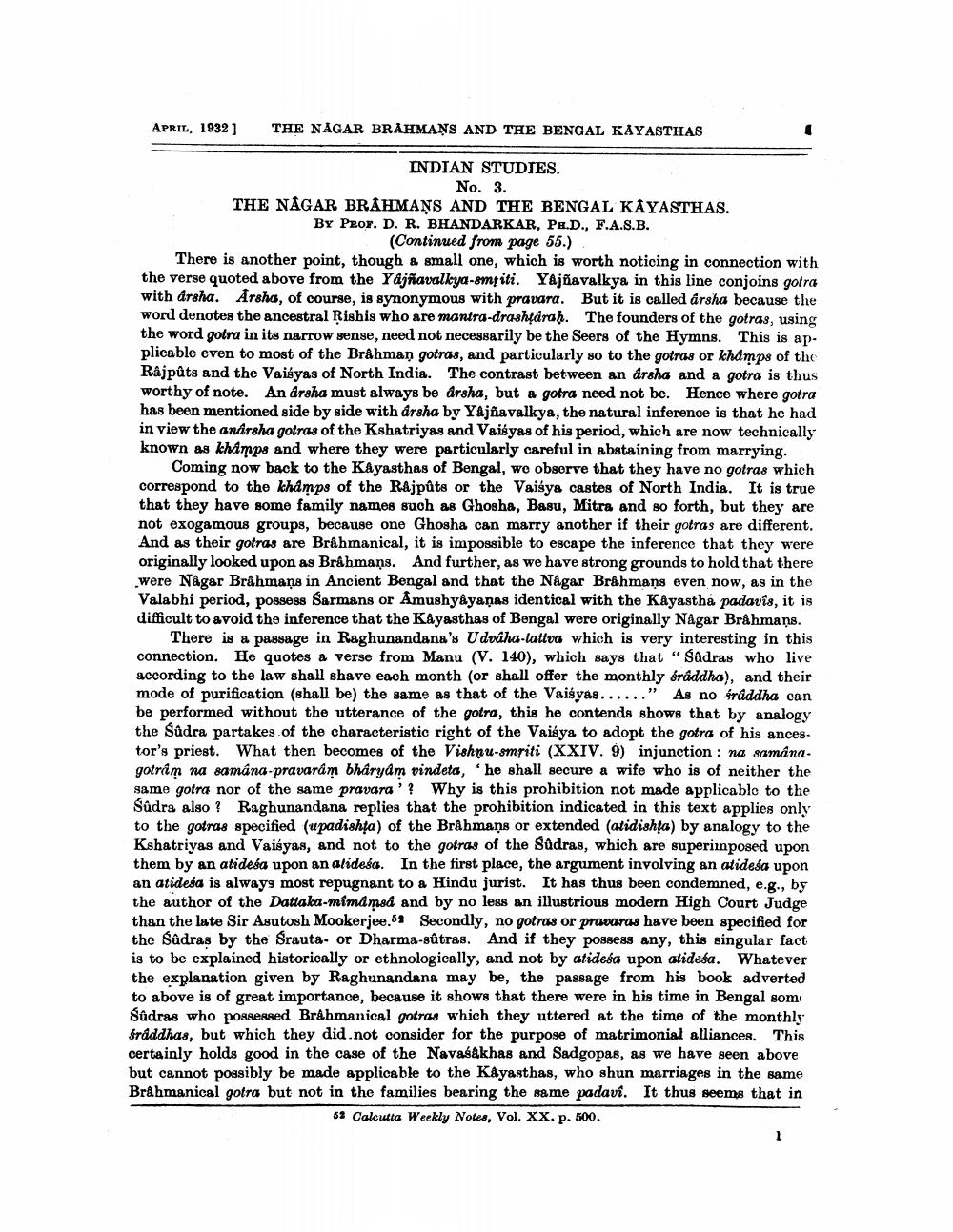________________
APRIL, 1932)
THE NÅGAR BRAHMANS AND THE BENGAL KÄYASTHAS
INDIAN STUDIES.
No. 3. THE NÅGAR BRAHMANS AND THE BENGAL KAYASTHAS. BY PROY. D. R. BHANDARKAR, PH.D., F.A.S.B.
(Continued from page 55.) There is another point, though a small one, which is worth noticing in connection with the verse quoted above from the Ydjfiavalkya-smriti. Yajñavalkya in this line conjoins gotra with drsha. Arsha, of course, is synonymous with pravara. But it is called arsha because the word denotes the ancestral Rishis who are mantra-drashtdrah. The founders of the gotras, using the word gotra in its narrow sense, need not necessarily be the Seers of the Hymns. This is applicable even to most of the Bråhman gotras, and particularly so to the gotras or khámps of the Rajpûts and the Vaisyas of North India. The contrast between an drsha and a gotra is thus worthy of note. An drsha must always be drsha, but a gotra need not be. Hence where gotra has been mentioned side by side with drsha by Yajñavalkya, the natural inference is that he had in view the andrsha gotras of the Kshatriyas and Vaisyas of his period, which are now technically known as khamps and where they were particularly careful in abstaining from marrying.
Coming now back to the Kayasthas of Bengal, we observe that they have no gotras which correspond to the khamps of the Rajpûts or the Vaisya castes of North India. It is true that they have some family names such as Ghosha, Basu, Mitra and so forth, but they are not exogamous groups, because one Ghosha can marry another if their gotras are different. And as their gotras are Brahmanical, it is impossible to escape the inference that they were originally looked upon as Brahmans. And further, as we have strong grounds to hold that there were Någar Brâhmans in Ancient Bengal and that the Någar Brâhmans even now, as in the Valabhi period, possess Sarmans or Amushyâyaņas identical with the Kayastha padavis, it is difficult to avoid the inference that the Kayasthas of Bengal were originally Nagar Brahmans.
There is a passage in Raghunandana's Udváha-lattva which is very interesting in this connection. He quotes a verse from Manu (V. 140), which says that "Sadras who live according to the law shall shave each month (or shall offer the monthly sraddha), and their mode of purification (shall be) the same as that of the Vaisyas......" As no sråddha can be performed without the utterance of the gotra, this he contends shows that by analogy the Sudra partakes of the characteristic right of the Vaisya to adopt the gotra of his ances. tor's priest. What then becomes of the Vishnu-smriti (XXIV. 9) injunction: na samana. gotram na samána-pravaram bharydm vindeta, he shall secure a wife who is of neither the same gotra nor of the same pravara'? Why is this prohibition not made applicable to the Sudra also ? Raghunandana replies that the prohibition indicated in this text applies only to the gotras specified (upadishta) of the Bråhmans or extended (atidisha) by analogy to the Kshatriyas and Vaisyas, and not to the gotras of the Sudras, which are superimposed upon them by an atideća upon an alidesa. In the first place, the argument involving an atidesa upon an atidesa is always most repugnant to a Hindu jurist. It has thus been condemned, e.g., by the author of the Dattala-mimamsd and by no less an illustrious modern High Court Judge than the late Sir Asutosh Mookerjee.59 Secondly, no gotras or pravaras have been specified for the Sadras by the Srauta- or Dharma-sûtras. And if they possess any, this singular fact is to be explained historically or ethnologically, and not by atidesa upon alidesa. Whatever the explanation given by Raghunandana may be, the passage from his book adverted to above is of great importance, because it shows that there were in his time in Bengal som Sudras who possessed Brahmanical gotras which they uttered at the time of the monthly Sraddhas, but which they did not consider for the purpose of matrimonial alliances. This certainly holds good in the case of the Navasakhas and Sadgopas, as we have seen above but cannot possibly be made applicable to the Kåyasthas, who shun marriages in the same Brahmanical gotra but not in the families bearing the same padavi. It thus seems that in
69 Calcutta Weekly Notes, Vol. XX. p. 500.




